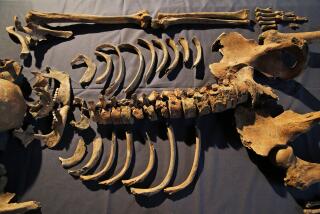Did Columbus Give Old World Syphilis? : Medicine: Debate over the origins of the sexually transmitted disease has never abated. Resolution may be near, however.
- Share via
In the year 1500, not long after Christopher Columbus and his crews began returning from their voyages to the New World, an epidemic of syphilis erupted in Europe. Shortly thereafter, more epidemics flared and swept across the continent, raging with much the same impact as AIDS does today.
Sixteenth-Century European physicians said it was a disease they had never seen before, and some maintained that it had been introduced by Columbus’ men, who had become infected in the Americas.
The sexually transmitted disease was established throughout Europe within a few years, and it remained one of the worst diseases plaguing the continent--and eventually every place Europeans traveled--until penicillin became available in the 20th Century.
Debate over the origin of syphilis, however, has never abated. Now, as the 500th anniversary of Columbus’ first voyage draws near, one of the most heated controversies spawned by the meeting of Old World and New--what historians and anthropologists both refer to as “contact”--may be nearing resolution. At least in the minds of some.
In the centuries since contact, scholars have generally taken one of two positions.
One--the pre-Columbian theory--is that syphilis had been in Europe since ancient times but that it was confused with leprosy. In fact, some medical treatises of Columbus’ day describe leprosy as a sexually transmitted disease with a short incubation period. They said it could also be transmitted congenitally and would respond to treatment with mercury compounds.
True leprosy, we know today, fits none of those characteristics; but syphilis fits them all.
Syphilis begins with sores on the genitalia and can progress to cause severe disorders of the heart and circulation. In some cases it leads to neurological diseases and, eventually, insanity. When acquired during fetal development, syphilis leads to a wide variety of physical malformations and functional defects.
The chief rival position--called the Columbian theory--argues that there was no syphilis in Europe until Columbus took it there. Advocates of this view agree that what was then called leprosy was a mixture of true leprosy with other sexually transmitted diseases, but that none of them was syphilis. More likely, they argue, the other disease was gonorrhea.
*
Because advanced syphilis can cause permanent damage to the bones--creating characteristic pits and eroded areas on the skull and the shin bone, giving them what is sometimes called a “worm-eaten” appearance--scientists and physicians have sought at least since 1875 to resolve the debate by examining the skeletons of Europeans and American Indians who lived before 1492.
They have studied thousands of skeletons from prehistoric burial grounds all over North and South America and from the graveyards of Europe’s leper asylums--precisely where the pre-Columbian theory would predict syphilitic skeletons to be most common.
Although interpretations have varied, the consensus is that no unequivocal effects of syphilis can be found among the remains of the “lepers,” whereas many skeletons of pre-Columbian Americans do show the scars that look like the effects of syphilis.
“I personally have examined 3,000 or 4,000 skeletons in Italy, pre-contact, and I can find no sign of syphilis,” said George J. Armelagos, an anthropologist at the University of Florida in Gainesville. “Other people have looked in Spain, other countries, and found nothing. After contact, the story is different. Then you see it.”
The New World presents a different picture. Pre-contact skeletons often show damage resembling that of syphilis. But with a difference, Armelagos said. The bone damage is less like that of syphilis and more like that of yaws, a different disease caused by the same spiral-shaped bacterium, called treponema. Somehow the same bacterium causes different symptoms depending on how it is acquired.
Yaws is a chronic disease usually acquired in childhood. Early stages show up as large, long-lasting sores, typically on the legs and arms. Years later, benign tumors of the skin and leg bones are common. In the late stages the bacterium can eat away the nose, upper jaw and throat. Yaws is spread by casual contact among children with poor hygiene and frequent skin injuries.
Armelagos and Brenda J. Baker at the University of Massachusetts at Amherst have suggested that treponemal disease--whatever its manifestation--originated in the New World and was spread among early American Indian children as yaws. Because many adults were infected as children and may have had acquired a degree of resistance, sexual transmission probably would not have caused the disease, the anthropologists suggest.
When Columbus and his men arrived, however, the only way they could have picked up the bacterium would have been through sexual intercourse. When they returned to a Europe that had no prior exposure (but had a level of hygiene that minimized spread among children), Baker and Armelagos suggest, the disease spread like wildfire sexually. The bacterium that caused yaws under New World conditions would, in the Old World where hygiene was different and where immune systems were different, cause syphilis.
*
The account, however, may not be so simple. Armelagos said there is a new report of a pre-contact English skeleton showing signs of treponemal damage.
“If that turns out to be true, we’re going to have to re-evaluate the whole situation,” Armelagos said.
Smithsonian anthropologist Don Ortner thinks a re-evaluation is in order, given the English skeleton and new evidence that treponema infections may have existed in Africa, with which Europe traded long before Columbus’ time.
“If I can be convinced that that English specimen had treponemal disease, then the question is solved,” Ortner said. It would mean treponema was in Europe before Columbus ever dreamed of a new route to the Orient.






